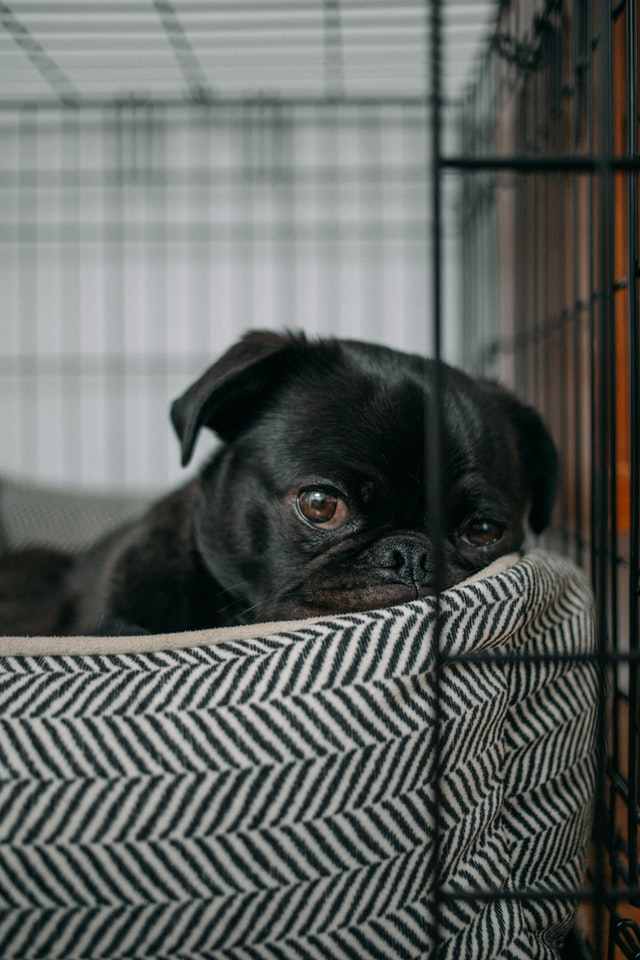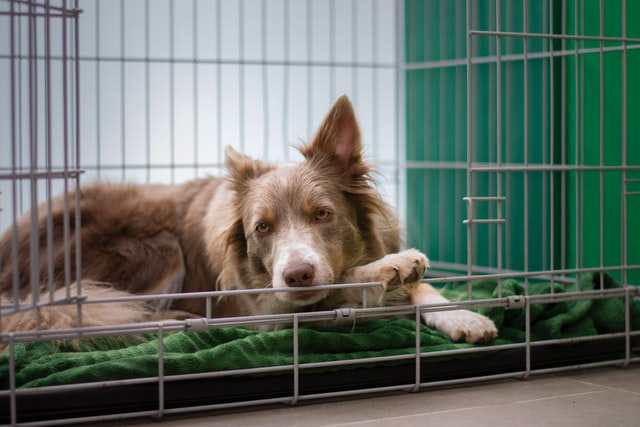A dog that wants to go into the crate too often, spends too much time in the crate, or won’t come out, these are issues that are not as common as dogs hating the crate.
Most new dog owners having a hard time crate training a new puppy, especially one that hates the crate would not even look at these situations as problems.
However, it’s much easier to crate train a puppy than it is to make one that doesn’t want out of the crate to stop going in too often.
There are multiple reasons why a dog would go into his crate, or wouldn’t want to come out, and that’s what we’ll be analyzing next.
My dog won’t come out of his crate

Sometimes the reason why your puppy doesn’t want to leave his crate can be obvious, like fear. Many times it’s hard to detect the true reason why and therefore it can be hard to deal with it.
This is why we’ll be listing the most common reasons and explaining some of the signs you should look for to understand why and take the correct actions.
Fear
Fear is the most common reason why dogs would go into the crate and won’t want to come out, fearful dogs look for a safe space and that’s what the crate represents.
Just like us, it’s hard to leave the safety of your home when in fear, no matter what the reason might be.
Recognizing that the dog is fearful is the first and most important step, and you can do that based on your dog’s body language.
Signs of Fear, Anxiety, and Stress:
Things to look for include a tucked tail, ears back, licking the lips or nose, whale eye (wide eyes showing the whites of the eyes), looking away, lifting a paw, trembling or shaking, a low body posture, yawning, panting, grooming, sniffing, seeking out people (e.g. looking for comfort from you), hiding, not moving, a stiff or frozen posture, urinating and defecating.
companion animal psychology
Fearful dogs refusing to leave the crate are often observed in two situations, a new dog that you’ve just brought home, especially rescued dogs that have been abused in the past, or crate trained dogs that are suddenly afraid of something.
In both cases, the crate represents a safe den in which they feel safe and won’t leave as long as the scary “thing” is not gone, which could be a person, a pet, or anything really.
Illness
Being sick is another reason why a dog would not leave his crate, injured or ill dogs in pain prefer to calm down somewhere safe and comfy.
It can be hard to tell if a dog is sick but a sudden lack of energy and spending too much time in the crate are good signs.
Your dog is refusing food and doesn’t react when called, changing sleeping positions, and napping for too long, these are also signs of illness.
Depression

It might sound like too much of a stretch but it’s not very uncommon for dogs to get down especially during periods of change; said Dr. Bonnie Beaver of the American College of Veterinary Behaviorists.
The good news is that it’s rare for dogs to suffer from long-term depression, so it’s generally a phase, that you need to help your dog get through.
It is hard for veterinarians to actually tell if a dog is depressed, you can’t just ask, but in cases of loss and sudden changes, and no apparent sickness, you might want to consider depression.
Sudden change
For dogs that are crate trained, the crate is a safety net, a place where they can relax when feeling uncomfortable, and that’s actually one of the benefits of crate training.
It can help you easily detect that something is bothering your dog, and when we say change, it doesn’t have to be something significant.
A new person in the house, or a new pet can make the dog feel uncomfortable and drive him to the safety of his den.
Any change that is going to affect your dog doesn’t have to be sudden, a new baby coming, moving to a new home, a new boyfriend…
You have to properly prepare your dog to be part of the change and not subject to it, introduce new people and pets, let the dog explore new places, and include him in his environment.
Aging
Dogs do tend to calm down as they grow older, elderly dogs are less energetic than young puppies, and it’s normal behavior.
Just like us, dogs can have mobility issues caused by arthritis as they grow older, it can be painful to move around too much.
Staying in the crate seems like a great way for them to relax and just enjoy the world passing by without any physical stress.
Unfortunately, dogs share many of our other degenerative problems, even their minds can start to function differently as they age.
Senior dogs can become grumpy and enjoy loneliness more than the company, which is understandable but they do need some level of activity to stay fit physically and mentally.
Seeking attention
Some wickedly smart and mischievous dogs can use the crate to seek attention from their owners.
Dogs enjoy the company of their owners and they want a minimum of attention, with us being too busy and carried away some dogs find unique ways to let us know.
If your dog won’t come out of the crate when called and leaves gladly when you come there and give him a good rub and some praise, he could be the next nominee for an Oscar.
New puppy won’t come out of crate
A new puppy that won’t come out of the crate is probably afraid, the sudden change in his life, leaving his mom and littermates can be scary.
Young puppies can be fearful at times especially in the first few days, a whole new world is around them and they can’t recognize anything so the crate could be the only place where they feel safe.
For new puppies, it usually is a matter of time before they get used to their new environment, a few meals and he’s loving life.
Puppies are curious by nature and will eventually when they calm down get out of the crate to explore their surroundings.
Using the puppy’s curiosity to lure him out can be a good move, just make sure to use a few treats and praise to calm the puppy in his crate and don’t force him out.
Why is my dog staying in his crate?
It is not unusual for dogs to just stay in their crate sometimes, they spend a good part of their day just loafing anyway.
Dogs spend around half their day sleeping, and a good part of the wake time just relaxing, if the crate is where a dog feels comfy he’ll be in there for a good part of his day.
It becomes unusual when the dog spends the whole day in his crate and doesn’t want to leave for anything.
Dogs sleep and loaf a lot but they do have bursts of energy when they want to play and hang out with their owners, and staying in the crate all the time is not normal.
My dog wants to stay in his crate
A dog that wants to stay in his crate all day and is no longer interested in playing or any sort of activity is not feeling fine.
Dogs can feel down at times, or maybe be sick and want to stay in the crate, this is perfectly fine and understandable.
The crate being the comfort zone for your dog that’s where he wants to be when not feeling great.
When this happens for extended periods of time and wants to stay all day in there is where you should do something about it.
Dog puts himself in crate too often

Dogs can change their behavior as they mature, some breeds do tend to calm down after they reach maturity.
You might notice that your dog goes into the crate too often compared to what he’s used to before, hyperactive breeds can do that.
Elderly dogs also tend to get less energetic and prefer to go more often into the crate to relax, for longer periods as they grow.
Dog suddenly sleeping in crate
This is not necessarily bad news especially if you’ve been trying to crate train your dog but did not succeed.
It’s not unusual for dogs to change their sleeping location, or maybe you’ve been pushing the crate too hard, then he realized it’s not that bad.
Sleeping and napping in the crate is what we and most experts recommend anyway, so as long as your dog leaves the crate during the day and is normally active, there is nothing wrong with it.
Letting your puppy sleep in bed with you is not a very good idea anyway, so as long as he doesn’t spend too much time in the crate it’s fine.
How to get scared dog out of crate?
Your number one priority with a scared dog is to help him feel safe.
Using praise and comforting words can help, but identifying what’s the puppy is afraid of is important.
It can be anything, a person, a sound, or a new pet, and once you’ve identified what’s wrong, try to make it disappear if it’s something that can be discarded or else if it’s a person or a new pet make proper introductions.
The best way to approach a scared dog is to remove whatever or whoever he’s scared off from the scene first.
Once your dog is feeling comfortable enough to get out of the crate, you can properly and gradually introduce him to the new person/thing.
Should I force my dog out of the crate?
No matter what the reason a dog is refusing to leave his crate, forcing him out is not a good idea, or forcing him in for that matter.
Dogs don’t respond well to obligation and force, taking things slow and gaining their trust is the way to get them to do what you want.
Some stubborn breeds will just react aggressively to being forced out of the crate, and it could be traumatic to a scared dog seeking safety in the crate.






